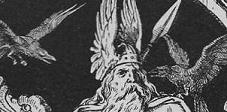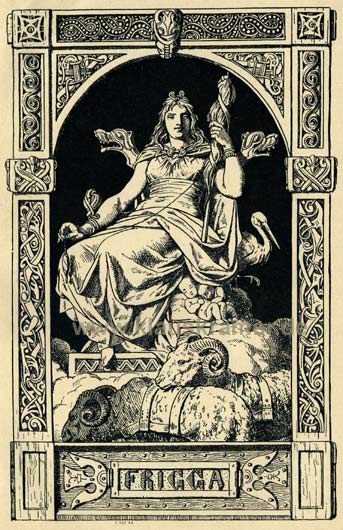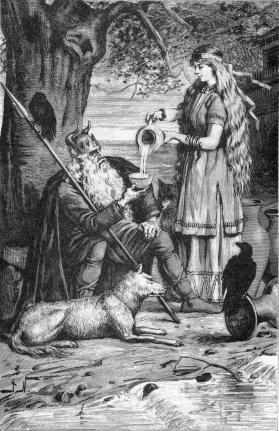The Poetic Edda: A Study Guide
The Speech of the Masked One

[PREVIOUS][MAIN][NEXT]
[HOME]
MS No. 2365 4to [R]
AM 748 I 4to [A]
Normalized Text:
7. Sarcqua beccr heitir e IIII,
en þar svalar knegu
unnir yfir glymja;
þar þau Óðinn ok Sága
drekka um alla daga
glöð ór gullnum kerum.
7. Sökva bækr hæitir hinn fjórð,
en þar svalar knegu
unnir yfir glymja;
þar þau Óðinn ok Saga
drekka um alla daga
glöð ór gullnum kerum.
7. Sökkvabekkr heitir inn fjórði,
en þar svalar knegu
unnir yfir glymja;
þar þau Óðinn ok Sága
drekka um alla daga
glöð ór gullnum kerum.
in Icelandic Poetry
“The Song of Grimnir”
The Yale Magazine, Vol. 16
“The Song of Grimner”
VII. Saucquabeccer is the name,
The next immortal, portals claim;
There icy waters ev'ry hour,
Around in horrid diss'nance pour;
While Odin, Saga, orgies hold,
Quaffing libations out of gold.
The dismal sound of roaring waters, cold
And restless, ceaseth not in Söcqua-beck,
Where joyful Odin drinketh every day,
With Saga mirthfully draining the vases of gold.
in Edda Sæmundar Hinns Frôða
“The Lay of Grimnir”
in Corpus Poeticum Boreale
“The Sayings of the Hooded One”
7. Sökkvabekk the fourth is named
oe’r which the gelid waves resound;
Odin and Saga there,
joyful each day,
from golden beakers quaff.
Sunkbench the fourth is called, where the cold waves ever murmur above ; there Woden and the Seeress drink every day joyfully out of golden cups.
in Edda Saemundar
“The Sayings of Grimnir”
in The Poetic Edda
“Grimnismol: The Ballad of Grimnir”
for ever,
the chill waves are rushing over ;
while day by day drink Odin and Saga,
glad-hearted, from golden cups.
7. “Falling-brook”: Sokkvabekkr has usually been rendered Sinking-bench; Detter suggests the above.
7. Sökkvabekk is the fourth, where
cool waves flow,
And amid their murmur it stands;
There daily do Othin and Saga drink
In gladness from cups of gold.
in The Poetic Edda
“The Lay of Grimnir”
in The Elder Edda
“The Lay of Grimnir”
7. Sokkvabekk12 called is the fourth, which cool waters ripple round about;
there Othin and Saga13 all their days
drink,
glad from golden cups.
12 "Sunken Hall" (?). Compare with Fensalir in
"Voluspa," St. 33.
13 "Seeress," Frigg. The name is etymologically connected, but not
identical, with the Norse word for "history," "story."
7. The fourth Sunk-Bench: refreshing waves
Sparkle and splash about it:
There Odin drinks all day with Saga,
Glad from golden cups.
in The Poetic Edda
“Grimnir’s Sayings”
in The Poetic Edda, Vol. III: Mythological Poems
“The Lay of Grimnir”
resound over it;
there Odin and Saga drink everyday, joyful, from golden cups.
7. Couch of Sunk Treasure the
fourth is called,
and there cold, overhead,
the loud waves wash.
There Óðinn and Sága
all the days through
drink gaily from casks of gold.
2011 Andy Orchard
The Elder Edda: A Book of Viking Lore
'The Lay of Grimnir"
7. ‘Sunken Bench a fourth is called, and there cool waves
can thunder over the place;
there Odin and Sága drink every day,
gladly, from golden cups.
Oðinn's Wife : Mother Earth
 |
The Goddess Saga
Ursula Dronke, The Poetic Edda, Volume II (1997):
Völuspá 33/6: "Fensölom [Fensalir]: no doubt a subterranean water-palace like the submarine Søkkvabekkr (Grímnismál 7). Fen, 'quagmire,' might imply great pools leading deep down into the marshes, such as those into which Egill cast his treasure and his slaughtered slaves as an offering to Óðinn (Egil 297-8). On the association of the goddesses with prophetic water-realms see ...Völuspá 20/3, Lokasenna 21/2-6. Sága, who drinks with Óðinn in Søkkvabekkr, personifies Frigg's aspect as a 'prophetess' [Jan deVries, Altgermanische Religionsgeschichte, 2 Vol. (1956-57)."
Ursula Dronke, The Poetic Edda, Vol. III (2011):
"Óðinn and his lady enjoy their golden goblets in a treasure-lounge beneath the sea (7)."
Andy Orchard, The Elder Edda, (2011) p. 282:
"It may be that 'Sunken-Bench' (Sökkvabekkr) is another name for 'Fen-halls' (Fensalir), where Frigg weeps for Baldr (Völuspá 33). Sága is an otherwise unknown goddess, according to Snorri (Gylfaginning 35) who simply paraphrases this stanza, but it is likely another name for Frigg."
Among the Germanic tribes, serving mead is considered the
province of high status women. The order in which she serves the mead, indicates
the rank of the gathered guests. The warlord (in this case Odin) would be
served first by his wife, followed by his closest retinue (the gods and
Einherjar) in order of importance. Not only does Saga serve Odin from golden
cups, she does so every day. This suggests that Saga herself is a goddess of
very high rank. Yet, her name is not found elsewhere in Eddic poetry. That being
the case, Saga may simply be an epithet for a better known goddess. Snorri
ranks Saga second after Frigg, but then later says that Freyja holds that honor.
The Lady with a Mead Cup, 1996, by Michael J. Enright, p. 127
"The evidence indicates that a very strong correlation existed between the
concept of aristocratic femininity among the Germans and the ability to
distribute liquor. In the Lübscow graves, the first series to provide
indisputable evidence of hierarchic demarcation, we find a certainly high-status
woman buried in a new type of way and with a wine strainer in her hand. These
graves depict a dramatically changed conception of rank which many archeologists
now associate with foreign influence and the comitatus. Hence, it will not do to
describe the strainer as simply a sign of generalized notions of open
hospitality which might be connected with women. The strainer is not there to
suggest commensality and an altruistic willingness to share good things. It is a
notable cultural artifact which indicates an ability to provide the best for the
best, a token of status but not hospitality. The secondary derivative must not
be confused with the primary one. This is the clear message of the spoon
strainers of the migration/Merovingian period of Central Europe and England.
Serving the same function as the larger strainers, they hung on rich women’s
belts with keys. They were at least the female equivalent of the long swords in
warriors’ graves."
 p. 286
p. 286
"Prophecy, sexuality and the distribution of liquor are not infrequently
affiliated themes in the literature of the Middle Ages. Nonetheless, with some
exception for the latter two, scholars have commonly discussed them separately.
They have failed to recognize the complete rationale for Tacitus’ attribution of
the power of prophecy to women and the cogency of his remarks on the state of
inebriation and the choosing of chiefs. These are now explainable. Both weaving
and the brewing of beer were women’s work. The weaving of cloth was universally
regarded as closely analogous to the weaving of fate and weaving tools like the
spindle and whorl were also imbued with strong sexual connotations. The goddess
on 6th century braceates is depicted with large breasts and carrying a weaving
beam and a weaving sword as attributes. The brewing of liquor was similarly
mystical. In effect, it produced pleasure while encouraging inspiration and
furthering community. So too did the woman herself, but then she also served the
drink and, because of the method of service on significant occasions, formalized
status. Any other result would be surprising since the adoption of thoroughly
hierarchic comitatus guaranteed that the liquor offering would become a more
officially symbolic statement of ranking than ever before even though fictive
kinship was also created. For the mythopoetic mentality of the time, each of
these associations led ineluctably to the other. Hence, the warlord, the husband
and the follower all received their cup and commonly made oaths and heard wishes
for the future when they drank from it."
John Lindow, The Handbook of Norse Mythology, pp. 264-5
Saga: Minor Goddess. Snorri lists her second in his catalog in Gylfaginning of
goddesses among the æsir, after Frigg, and says only that she lives at the great
farm Søkkvabekk [Sunken-bench]. In Grímnismál 7, Odin includes Søkkvabekk as the
fourth of the residences he surveys and says that cool waves resound over it:
“there Odin and Saga/drink through all the days/ happy, out of a golden cup.”
The similarity of Søkkvabekk to Fensalir, Frigg’s dwelling; Odin’s open drinking
with Saga; and the usual etymology of the name, which relates it to the verb
sjá “to see” and understands her as a seeress, have led some scholars to
understand Saga as another name for Frigg.
In Gylfaginning 35, Snorri writes:
“Then spoke Gangleri: ‘Who are the Asyniur?’
High said: ‘The highest is Frigg. She has a dwelling called Fensalir and it is
very splendid. Second is Saga. She dwells at Sokkvabekk, and that is a big
place.” [Faulkes’ tr.]
Snorri adds no additional information, and it would seem rather obvious that his
information was in fact derived directly from Grimnismal 7.
Rudolf Simek, Dictionary of Northern Mythology, p. 274.
"It has been suggested that the name Sága is related to the Old Norse
sjá (Germanic *sehwan) ‘see’. As Frigg is called a
seeress in Lokasenna 21, and the names of Søkkvabekkr and Frigg’s
residence Fensalir are also similar in meaning, it would appear that
Sága is merely another name for Frigg. However, apart from phonetic
problems—despite the vowel quantity a link is more likely with saga
and segja ‘say, tell’, an identification such as this is
somewhat problematic. Sága should be thought of as one of the not closer
defined Asynjur (Hlin, Sjofn, Snotra, Var, Vor) who should probably be
seen as the protective goddesses. Those goddesses were all responsible
for specific areas of the private sphere, and yet clear differences were
made between them so that they are in many ways similar to the matrons."
In regard to this, the reader should be aware that only Snorri catalogs
these minor goddesses, and in some instances his catalog conflicts with
the evidence from earlier heathen poems. For example, in Eddic and
skaldic poetry, Hlín is a by-name for both Frigg, as in Völuspá 56, and
for Earth. In verse 13 of Hávarðar saga ísfirðings, lines 5-6 read: "No
man fell upon Hlin to a greater advantage for me, than this man." Here
Hlin is used as a byname of Jörd. “To fall upon Hlin” means to “fall
down,” “to die.” Thus Hlin is a poetic synonym for both Frigg and Jörd.
In skaldic poetry, the phrase “Odin’s wife” is a common kenning for
Earth, and in Eddic poetry, Frigg is Odin’s wife. I noted earlier that
there is strong circumstancial evidence that Frigg is the Earth goddess.
Her role in the Balder myth best demonstrates this. Thus, in heathen
poetry, the names Hlin, Jord and Frigg are all epithets of Odin’s lawful
wife, the Earth goddess and mother of the gods. Like all mythic figures,
she has numerous names. Odin himself is said to have 49 names in all,
many of which we shall encounter at the end of Grímnismál.
The Germanic folktale figure Frau Holle is most likely a memory of
Odin’s wife, Frigg. She is known as Holle, Bercht and Percht in
Germany. In southern Denmark, she is called Frau Frekka (cp. Frigga) and
in the Netherlands, Frau Gode. Gode is simply a form of the name Odin
(Wotan, Godan). Thus, Frau Gode is Mrs. Odin. In Sweden, Odin is
well-known as the master of the Wild Hunt, while in German folklore Frau
Holle is commonly identified as the mistress of the Wild Hunt. In
Germany, Frau Holle lives in springs and pond. In a fairy-tale by
Grimm, the entrance to her abode is through a well. Compare this
imagery to the name of Frigg’s hall, Fensalir, “Halls of the Fen/Marsh”,
to Saga’s home, Sökkvabekk, the Sunken-bench, which waves sough over.
Like Frau Holle’s abode, the homes of both Frigg and Saga seem to be
partially or wholly submerged. Thus, it would seem the home
of Mother Earth was conceived of as located in marshy, fertile land,
dotted with ponds and lakes, areas naturally teeming with life.
[PREVIOUS][MAIN][NEXT]
[HOME]